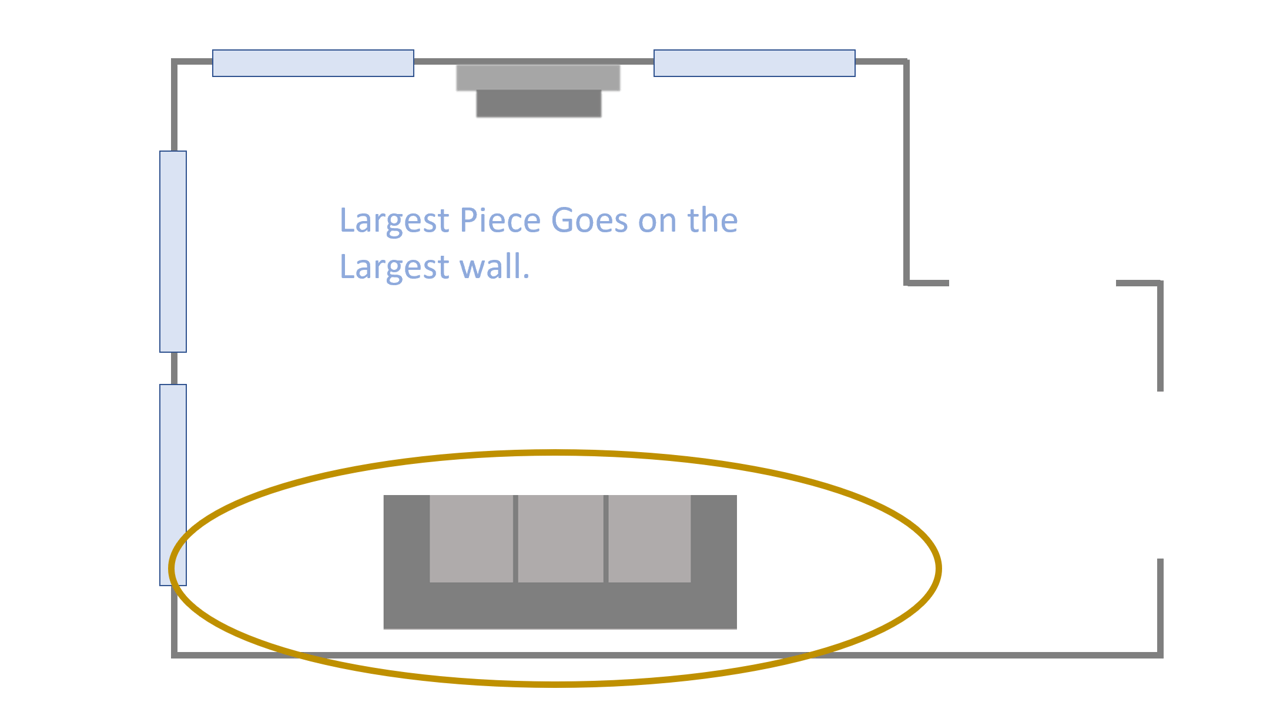Small living rooms can be tricky. You have a limited amount of space and you also want to have a room that looks great and functions the best way possible. I’ve lived in many small spaces and each one had its challenges and limitations. I’ve had lining rooms with multiple doorways, rooms that need to have dual functions: living and dining for example. No matter what, I’ve always used these 5 proven techniques to arrange furniture in a small living room and they work great every time. And, these techniques also work just the same for bedrooms, offices, dens and any other small space. Let me show you what I mean.
5 Proven Techniques to Arrange Furniture in a Small Living Room: 1. Measure Your Space and Furniture.
Measuring your floor space is by far the first and most important step in figuring out the best way to arrange furniture in any size room, especially a small living room. This is because you typically have more furniture in a living room than in a dining room, bedroom or office. You have a couch, chair or chairs, an entertainment piece: media console or cabinet. You’ll often have accent furniture: credenza, cocktail table, end tables, shelving. There’s a lot to consider and when you have all these pieces that need to co-exist in the same space, you have to be strategic with your placement.
· Start by drawing a floor plan of your new space. Sketch out the space like you’re on the ceiling looking down at it from above. When you know the size of your space you know the appropriate size furniture that will fit into it. The sketch doesn’t have to be perfect it just needs to have the shape of your room.
· Measure the furniture that you already have and record the measurements of the furniture that you are interested in purchasing so you can transfer those measurements to your actual floor plan.
· Put the measurements of each wall on the sketch, include the placement and dimensions of doorways, windows and any other architectural elements like fireplaces, columns, built-in shelving or furniture. It helps to do an overall length and width measurement so you can double check the dimensions.
· Snap a picture of the sketch on your phone so that you have it when you’re out shopping for the day. Include a few pictures of the room as well for reference. I like to snap a picture of each wall from the opposite wall and one of each corner form the opposite corner. That way I have a full view of my space and I have a visual as well as measured cue to reference.
This will help you to avoid buying furniture that is too big for the space. It will also help you to determine the best position for furniture that you already have.
5 Proven Techniques to Arrange Furniture in a Small Living Room: 2. Determine Traffic Patterns.
,
You don’t want to have furniture obstructing pathways, in doorways, you don’t want to walk around or step over furniture to get into and through the room. Furniture blocking doorways makes a room look sloppy and not well planned. This is where the sketching process can really help you think through the placement. Sometimes a small space is like a puzzle: all the pieces must fit together so you can see the big picture.
When you sketch out your space and you can clearly see where the doorways, bump outs and other obstructions are, you’ll be able to see how you want to move around the room.
· Leave at least 3’ for entering into the room. You do not want to have furniture blocking your way into the space. Trust me, squeezing past the arm of a sofa I order to walk into the room will get old fast.
· Don’t try to jam furniture into spaces that are too small. For example, if you have a nook beside a fireplace, don’t cram your large sofa into. Think about that space as an opportunity to display some books and collectables on a shelf or etagere. You don’t have to fill the entire nook with something just because it’s an open space.
Leave at least 15-18” between the cocktail table and the sofa so you can move freely into the sofa. This same measurement can apply to chairs. You should be able to place a drink on the cocktail table without having to get up from the chair or stretch across the floor.
5 Proven Techniques to Arrange Furniture in a Small Living Room: 3. Determine The Focal Point.
Most rooms will have a natural focal point, a fireplace, beautiful window overlooking a spectacular view. What if your room doesn’t have a natural focal point? Then it’s up to you to create it. Where are you going to be focused? Think about how you want to use the space. Will the primary function be watching TV? Then that is your focal point. Will you be using the room for entertaining and receiving guests? Then the TV is not the focal point – you may not even want a TV in the room.. Form follows function. When you decide how you want the room to function, it’s easier to arrange your furniture.
5 Proven Techniques to Arrange Furniture in a Small Living Room: 4. Largest Furniture Goes on the Largest Wall.
Along the same lines as determining your focal point, sometimes the room dictates where furniture should be placed. In most cases, the largest piece of furniture should go on the largest, unobstructed wall. That is not a hard and fast rule for all times. A large television cabinet across from a group of large, sun drenched windows might not be the best place for the television to go because of glare. Conversely, a long sofa or sectional might be the be the perfect thing to occupy that long wall.
5 Proven Techniques to Arrange Furniture in a Small Living Room: 5. Create a Seating Group.
Don’t arrange your furniture in a straight line. Place furniture in a conversation grouping, imagine having a person in every seat. Do they have a comfortable way to see each other for conversation? Is there anything obstructing their view of each other? Adjust if needed.
1. Think outside the box: float furniture if needed to get functionality. This is a great way to add a new traffic pattern to the space. It’s especially pertinent when you have perpendicular doorways. By bringing the furniture off the walls, you instantly create a comfortable conversation grouping. It will also make the room seem larger.
2. Trick the eye into feeling there is more space: pull furniture away from the walls a couple of inches. Gives you depth and looks like there is more space behind than actually there: give your sofa a sofa table behind to bring it out a bit from the wall. There are lots of narrow sofa tables on the market. Utilize open shelving and tables that have the ability to see through them to the wall. Don’t over saturate the space with tons of décor. Again, leave space so you can see the wall and under tables to the floor. You don’t want to pack a small room full of furniture that is visually heavy.
There you have it: 5 proven techniques to arrange furniture in a small living room. By knowing your actual floor space, the traffic patterns, focal point, vantage point and how you’ll use the space, you will be on the right path for a comfortable, functional and beautiful living room.
I hope you enjoyed reading about arranging small living rooms. I appreciate you spending a few moments of your time with me today. I’d love to hear what you think, please leave a comment below. If you think this would be helpful for a friend struggling with a small room, pass it along.
Join The Fun
If you enjoyed this post and you want to keep seeing my weekly blog, the best way to do that is to subscribe.
You can subscribe by downloading my 11 Secrets Only Designers Know to Make Your Space Rock. If you’re curious about how decorators and designers make a home look magazine ready, you’ll love taking a gander at these 11 secrets. You’ll learn how to style your room from the floor up and it will work for ANY space you have.
You can also subscribe by taking my What’s Your Decorating DNA? quiz. It’s perfect to help you find your predominate decorating style so you can shop with confidence for anything your home needs.
I write about small space design and decorating, sustainable furniture options, positive self care and a variety of do-it-yourself home décor.
I’d love to connect with you!
“Michael Helwig was top-notch, very professional and responsive to my needs. He allowed me time to explore ideas and try out a variety of combinations until we found the perfect fit. Michael provided detailed information and offered beautiful ideas to make my dream living room become a reality. The furniture he sourced has totally transformed my living room space. Everyone that has seen my new living room has one word, WOW! A special thank you to Michael for a wonderful experience.”
“Michael was very knowledgeable and guided us, with great patience and good humor, through the process of designing our dining room and helping us find the perfect sleeper sofa. He offered really helpful advice when we asked questions - which was often - but at no time did we ever feel pushed. He helped me when I felt like I couldn’t make one more decision. When my new furniture finally arrived I realized everything down to the pillows was perfect. I couldn’t be happier!”
Michael is Principal designer and blogger at Michael Helwig Interiors in beautiful Buffalo, New York. Since 2011, he’s a space planning expert, offering online interior e-design services for folks living in small homes, or for those with awkward and tricky layouts. He’s a frequent expert contributor to many National media publications and news outlets on topics related to decorating, interior design, diy projects, and more. Michael happily shares his experience to help folks avoid expensive mistakes and decorating disappointments. You can follow him on Pinterest, Instagram and Facebook @interiorsmh.













